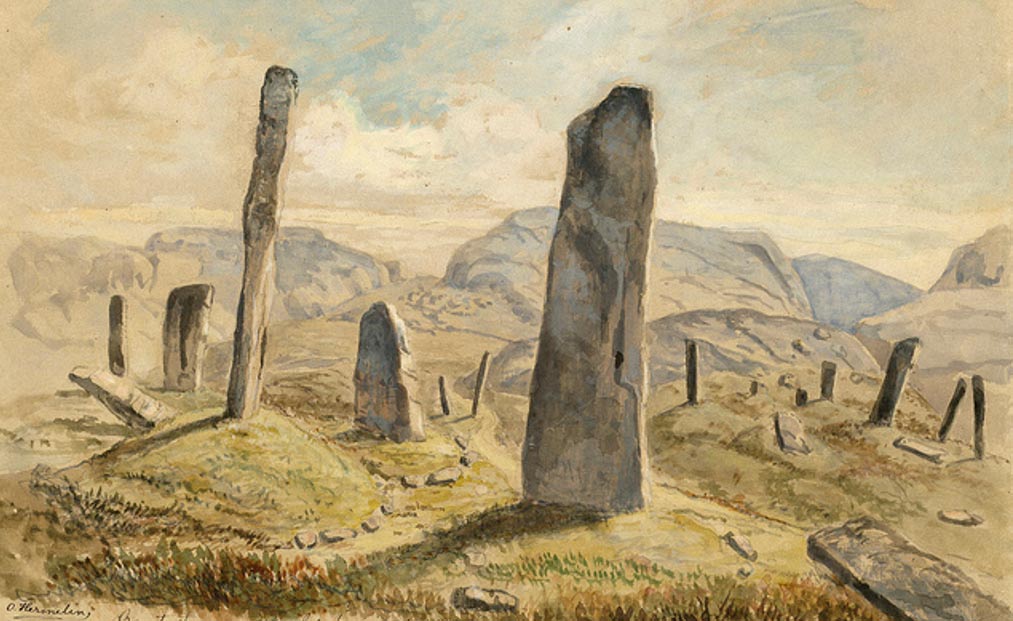Greby Grave Field: Final Resting Place of Scottish Warriors Theory Debunked
In many European countries, prehistoric monuments are often part of the scenery and taken for granted by those who live there. To the curious they are enigmatic, and all that is known about them is from the local folklore. One of the most fascinating prehistoric monuments in Sweden is the Greby grave field in Bohuslän. The grave field consists of some burials and a series of standing stones and it is of great historic significance since it has played an important part in the history of Swedish archaeology.
With Over 180 Graves, It Is the Largest Site of This Kind in Bohuslän
The field is located just off a busy road where each of the 180 stones are believed to mark a grave. It is likely that at one time there was a much larger number of stones, but down the centuries many were toppled or collapsed. These standing stones are known as menhir and are common across Europe - from the Atlantic coast of Ireland to the Baltic Sea. The stones vary in size and in general they measure approximately one to two meters (3 to 6 feet) in height. Some of the stones were once taller, but parts of them have broken off. Many of the menhir stand alone, but others are set in a circle, while some of the larger stones were set in mounds of earth. These monuments were set up to memorialize the dead and it is believed they were once engraved. However, now they have been effaced by the elements and time.

Standing stones at Greby grave field (Lundberg, B. A. / CC BY 2.5)
Based on similar monuments in Sweden and elsewhere, the stones would have had symbols, signs, and images inscribed on to them which would have been of immense spiritual significance. The dead would have been buried underneath the stones.
The Legend of the Greby Standing Stones
The area was once home to a large trading settlement known as Tanum, which was located on the west coast of Sweden. It is claimed that many Scottish warriors died while raiding Tanum and the local people believe that the stones are the grave markers of these Scots warriors or pirates who died there during battle. According to local folklore, the settlement never recovered from the attack by the Scots and was eventually abandoned.
The Real History of the Grave Field
In the nineteenth century one of the pioneers in Swedish archaeology excavated some of the graves. There were no weapons found and no evidence of Scottish artifacts. The grave field was dated to the Iron Age and based on the finds it was in use during the 5 th and 6 th century AD. This would date the monuments from the Vendel period, the era before the Viking Age, which was a society dominated by clans and powerful war-leaders.

Example of a Vendel helmet (CC 2.5)
The archaeologist found grave goods such as Iron Age jewelry, as well as clay pots that held the cremated remains of the dead. This is very similar to the burial practices of the Vikings in later centuries as narrated in the Norse Sagas. The artifacts found included bone combs, ornaments, and everyday objects. Many of these were stylistically similar to artifacts found in Germany and the British Isles.
Experts believe that the graves were linked to the period when the area was a major trading center. When the stones were erected, the Sannäs Fjord was connected to the Baltic Sea at Havstensund and at Edsvik. The region was important in the Iron Age as it was rich agricultural land. There was some speculation that Greby was an important trading hub and that produce from the area was possibly traded with merchants visiting the area and that the graves Greby graves are those of merchants and traders rather than warriors. Recent excavations have added to the evidence that would indicate that trade was very important in this region.
Getting to the Greby Grave Field

Rock Carvings at Tanum (Fotolia)
The Greby burial ground is the largest in Bohuslän, Sweden and it is located on Road 163 just before Grebbestad village. The stones are not that far from the rock at Tanum that have been declared a UNESCO World Heritage Site.
Top image: Standing stones, Greby grave field Source (Public Domain)
By Ed Whelan
References
Widgren, M. 1983. Settlement and farming systems in the early Iron Age: a study of fossil agrarian landscapes in Östergötland, Sweden. PhD diss., Almqvist & Wiksell international
Available at: http://www.diva-portal.org/smash/get/diva2:559960/FULLTEXT01.pdf
Jesch, J (ed.) 2012. The Scandinavians from the Vendel Period to the Tenth Century: An Ethnographic Perspective. Boydell Press
Available at: https://www.amazon.com/Scandinavians-Vendel-Period-Tenth-Century/dp/1843837285
Price, N. 2008. Dying and the dead: Viking Age mortuary behaviour. The Viking World: 257-73 Available at: https://books.google.ie/books?hl=en&lr=&id=wuN-AgAAQBAJ&oi=fnd&pg=PA257&dq=viking+age+burial+practices&ots=4BfbWi0JqE&sig=OvYVpo_iqo60VAgTQfY_eh56IiY&redir_esc=y>.

















